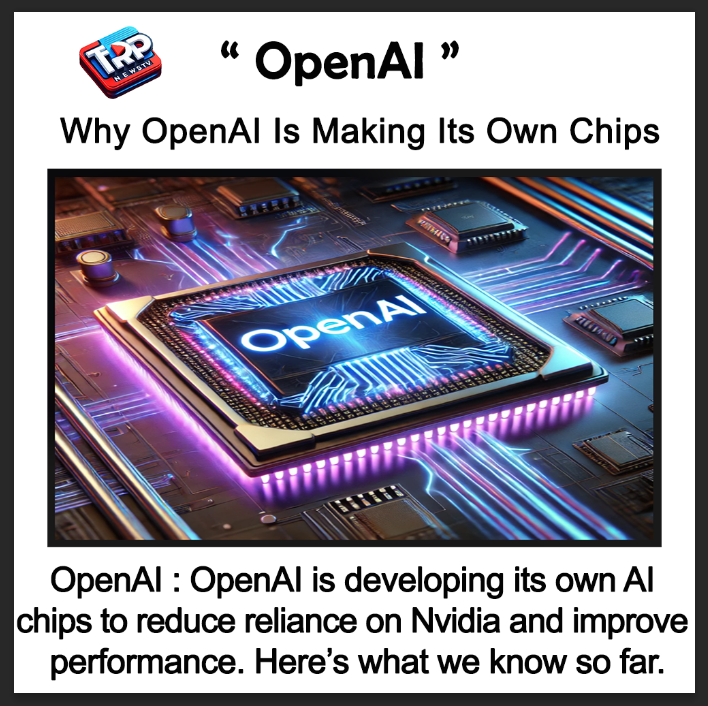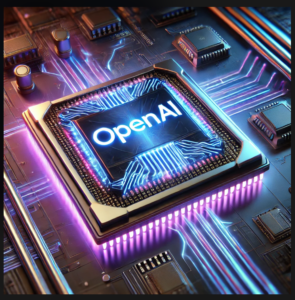
Why Is ChatGPT-Maker OpenAI Designing Its Own Chip? Here’s What We Know So Far
OpenAI, the company behind ChatGPT, is taking a major step towards technological independence by designing its own artificial intelligence (AI) chips. This move signals OpenAI’s ambition to reduce reliance on external suppliers like Nvidia, improve performance, and optimize costs.
With AI models becoming increasingly complex and requiring vast computational power, custom AI chips could be the game-changer OpenAI needs to stay ahead in the race. Here’s everything we know so far about this strategic shift.
1. Why Is OpenAI Developing Its Own AI Chips?

The demand for AI hardware has surged in recent years, with companies needing more powerful processors to train and deploy AI models. Currently, OpenAI relies heavily on Nvidia GPUs (graphics processing units) to power its models, but this dependency poses several challenges:
- High Costs: Nvidia’s AI chips are expensive, significantly increasing operational expenses for OpenAI.
- Supply Chain Issues: With the growing AI boom, demand for Nvidia’s chips has outpaced supply, leading to shortages.
- Performance Optimization: General-purpose GPUs are powerful but not always optimized for OpenAI’s specific needs. Custom chips could be designed specifically to enhance ChatGPT’s efficiency and speed.
To address these issues, OpenAI has started developing custom AI chips, which could provide greater control over hardware, better performance, and long-term cost savings.
2. How Far Has OpenAI Progressed?
OpenAI is not just experimenting with the idea—it’s already making serious progress. Reports indicate that:
- The company plans to finalize the design of its first AI chip by the end of 2024.
- OpenAI is expected to partner with Taiwan Semiconductor Manufacturing Co. (TSMC) to manufacture the chips.
- The chips will likely use advanced 3-nanometer technology, which is more efficient and powerful.
- Mass production is targeted for 2026, meaning it could take a few years before OpenAI’s chips become widely used.
Leading OpenAI’s custom chip initiative is Richard Ho, a former Google TPU (Tensor Processing Unit) engineer, bringing valuable experience to the team. The in-house team working on this project has now expanded to over 40 members.
3. What Are the Benefits of OpenAI’s Custom AI Chips?
Developing its own chips offers multiple advantages for OpenAI:
1. Reduced Dependency on Nvidia
By creating its own AI chips, OpenAI will no longer be at the mercy of Nvidia’s pricing and availability, reducing risks related to supply chain disruptions.
2. Optimized Performance
Custom AI chips can be tailored specifically for OpenAI’s AI models, improving efficiency, reducing power consumption, and enhancing the capabilities of ChatGPT and other AI tools.
3. Long-Term Cost Savings
While developing custom chips requires a massive initial investment, it could result in significant cost reductions over time, making OpenAI more financially sustainable.
4. Competitive Edge in AI Innovation
Owning the hardware it runs on will allow OpenAI to innovate faster, rather than waiting for third-party chip improvements.
4. Challenges OpenAI Faces in AI Chip Development
Despite the potential benefits, building custom AI chips is not an easy task. OpenAI faces several challenges:
1. High Costs and Investment Risks
Developing AI chips requires huge investments—from research and development to manufacturing and testing. If the chips do not perform as expected, it could lead to financial losses.
2. Technical Complexity
Chip design is extremely complex and requires deep expertise in hardware engineering, semiconductor fabrication, and AI model optimization.
3. Long Development Timeline
Unlike software, which can be updated frequently, chip design and production take years. If technology evolves rapidly during this period, OpenAI’s custom chips might become outdated before they even launch.
5. How OpenAI’s Move Fits Into the Industry Trend
OpenAI is not alone in its pursuit of custom AI chips. Several major tech companies have already taken similar steps:
- Google has developed its own Tensor Processing Units (TPUs), which power Google’s AI and machine learning services, including Google Search and Google Cloud AI.
-
Amazon has created AWS Inferentia and Trainium chips, designed to optimize AI workloads on Amazon Web Services (AWS).
-
Meta (Facebook) is working on custom AI chips to power its AI-driven products like Instagram, WhatsApp, and its Metaverse ambitions.
-
Microsoft has recently entered the AI chip space, developing its own AI processors to reduce dependence on Nvidia and AMD.
This trend shows that leading tech companies are moving toward hardware specialization, proving that owning the entire AI stack—from software to hardware—can be a huge competitive advantage.
6. When Can We Expect OpenAI’s Chips to Be Available?
If everything goes according to plan, OpenAI’s AI chips could be finalized by the end of 2024 and move into production by 2026. However, it’s likely that the first few generations of chips will be used internally before being made available to external customers or businesses.
For now, OpenAI is still expected to use Nvidia GPUs for the foreseeable future, but its long-term strategy is clearly shifting toward self-reliance.
Final Thoughts: A Smart Move for OpenAI?
OpenAI’s decision to develop its own AI chips is a bold but necessary step in the evolving AI landscape. While the company faces significant challenges, the potential benefits—cost savings, performance improvements, and greater independence—could give OpenAI an edge over competitors in the AI arms race.
If successful, OpenAI’s custom chips could redefine the future of AI hardware and change how AI-powered products like ChatGPT operate. For now, all eyes are on OpenAI as it works to bring its ambitious vision to life.




